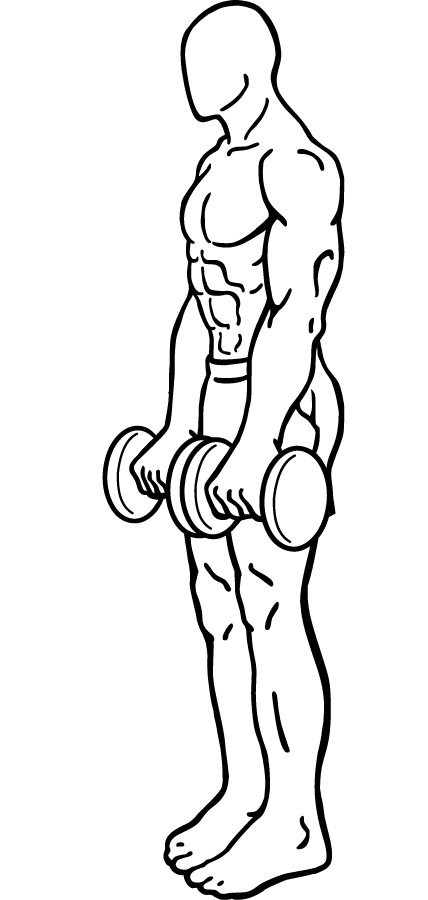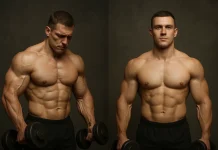Last Updated on September 30, 2022
Deadlifts are one of the most effective strength-training exercises, known for building power, improving posture, and enhancing functional strength. Traditionally performed with a barbell, the deadlift is also a core movement in powerlifting competitions. However, for those who prefer a more flexible or accessible option, dumbbell deadlifts provide an excellent alternative. This variation targets the same muscle groups—lower back, hamstrings, glutes, and calves—while offering additional benefits such as improved balance, control, and ease of use.
In this guide, we’ll explore everything you need to know about dumbbell deadlifts, including their benefits, proper form, common mistakes, variations, and tips for incorporating them into your workout routine.
Why Perform Dumbbell Deadlifts?
While barbell deadlifts are considered a cornerstone of strength training, dumbbell deadlifts come with unique advantages, making them a valuable addition to your workout regimen.
1. Versatility and Accessibility
Dumbbells are typically more accessible and versatile than barbells, especially if you’re working out at home or in a gym with limited equipment. You don’t need a barbell, weight plates, or specialized lifting platforms—just a pair of dumbbells.
2. Improved Range of Motion
Dumbbells allow for a greater range of motion compared to a barbell because they don’t restrict your movement in the same way. This can lead to a deeper stretch in your hamstrings and calves, promoting better flexibility and muscle activation.
3. Enhanced Balance and Coordination
Since dumbbells require more stability and coordination, performing deadlifts with them can help improve your balance and core strength. Unlike a barbell, where both hands hold a single bar, dumbbells move independently, forcing your body to engage stabilizer muscles to maintain control throughout the movement.
4. Reduces Strain on the Lower Back
Dumbbell deadlifts may reduce the load on your lower back, as you can adjust the weight more easily and maintain better control during the lift. This makes them a safer alternative for those who are recovering from back issues or just starting to learn the deadlift movement.
Muscles Worked in the Dumbbell Deadlift
Like the barbell deadlift, the dumbbell deadlift is a compound exercise that targets multiple muscle groups across your entire body. Here’s a breakdown of the primary muscles worked:
- Lower Back (Erector Spinae): The deadlift is one of the best exercises for strengthening the lower back, helping to improve posture and reduce the risk of back injuries.
- Hamstrings: Located at the back of your thighs, your hamstrings are engaged when you bend over to lower the dumbbells and straighten back up.
- Glutes: Your gluteal muscles play a crucial role in extending your hips as you lift the dumbbells, helping to build strength and power in your lower body.
- Calves (Gastrocnemius and Soleus): As you stand up and balance the dumbbells, your calves are activated to stabilize your body.
- Core: Your abdominal muscles and obliques work to maintain a stable posture during the lift, particularly as you control the weight at different stages of the movement.
How to Perform Dumbbell Deadlifts with Proper Form
Now that you understand the benefits and muscles worked in dumbbell deadlifts, let’s dive into the step-by-step process for performing the exercise with correct form. Maintaining good technique is essential to avoid injury and maximize results.
1. Set Up Your Stance
Begin by standing with your feet shoulder-width apart. Your toes should be pointing forward or slightly outward, depending on what feels most comfortable. This stance allows for optimal balance and power as you perform the lift.
2. Grasp the Dumbbells
With your arms extended at your sides, grasp a dumbbell in each hand using an overhand grip (palms facing you). The dumbbells should rest in front of your thighs, with your arms fully extended.
3. Engage Your Core and Straighten Your Back
Before initiating the lift, engage your core muscles by pulling your belly button toward your spine. This will help protect your lower back and keep your torso stable. Your back should remain straight throughout the movement—avoid rounding your spine, as this can lead to strain or injury.
4. Lower the Dumbbells
With a slight bend in your knees, hinge at the hips and slowly bend forward, lowering the dumbbells toward the floor. As you descend, push your hips back while keeping your chest up and shoulders down. The dumbbells should remain close to your legs throughout the entire movement.
Lower the weights until they are just above the ground or until you feel a deep stretch in your hamstrings, depending on your flexibility. Make sure your back remains straight, and your head stays in line with your spine.
5. Lift the Dumbbells
Once the dumbbells are at their lowest point, engage your glutes and hamstrings to initiate the upward movement. Push through your heels as you stand back up, keeping the dumbbells close to your body. Your hips should drive the movement as you return to a standing position, with your back straight and your core engaged.
6. Repeat the Movement
After standing upright with the dumbbells at arm’s length, repeat the process by bending at the waist again and lowering the weights. Perform 3-4 sets of 8-12 repetitions, depending on your fitness goals.
Tips for Perfecting Your Dumbbell Deadlift Form
To get the most out of your dumbbell deadlifts, follow these key form tips:
- Keep Your Back Straight: Maintaining a neutral spine is crucial to preventing lower back injuries. Avoid rounding your shoulders or arching your back during the lift.
- Use Your Hips, Not Your Back: The movement should primarily come from your hips as you push them back to lower the dumbbells and thrust them forward to lift. Your lower back should remain stable, not take the brunt of the load.
- Start with Lighter Weights: If you’re new to deadlifts or dumbbell deadlifts, start with lighter weights until you master the movement. Gradually increase the weight as you get stronger and more confident in your form.
- Control the Descent: Lowering the dumbbells slowly and with control will increase muscle activation and reduce the risk of injury. Avoid letting the dumbbells drop quickly.
Common Mistakes to Avoid
While the dumbbell deadlift is a straightforward exercise, it’s easy to make a few common mistakes that can hinder your progress or cause injury. Here’s what to watch out for:
1. Rounding the Back
One of the most common errors in deadlifting is rounding the back, especially as fatigue sets in. This puts undue strain on your spine and increases the risk of injury. Focus on keeping your back straight and your shoulders down throughout the movement.
2. Using Too Much Weight Too Soon
Another common mistake is starting with weights that are too heavy. This often leads to poor form and compensatory movements that can strain your muscles and joints. Start with lighter weights and increase gradually as you gain strength.
3. Not Engaging the Core
Your core plays a critical role in stabilizing your body during deadlifts. Failing to engage your abdominal muscles can result in poor posture and increase the strain on your lower back.
4. Bending the Knees Too Much
While it’s important to keep a slight bend in your knees during dumbbell deadlifts, over-bending them can turn the movement into more of a squat. The focus should be on hinging at the hips, not bending at the knees.
Variations of Dumbbell Deadlifts
Once you’ve mastered the standard dumbbell deadlift, you can try several variations to add variety to your workouts and target different muscle groups.
1. Single-Leg Dumbbell Deadlift
The single-leg variation is an excellent way to challenge your balance and improve unilateral strength. In this version, you lift one leg off the ground as you lower the dumbbells, placing more emphasis on your core and stabilizer muscles.
2. Sumo Dumbbell Deadlift
In the sumo variation, your stance is wider, with your toes pointing outward. This stance targets your inner thighs and glutes more intensely. It’s a great option if you want to mix up your lower body routine.
3. Romanian Dumbbell Deadlift
The Romanian deadlift (RDL) focuses more on the hamstrings and glutes by limiting the range of motion. Instead of lowering the dumbbells all the way to the floor, you stop when the dumbbells reach knee height before returning to the starting position.
4. Deficit Dumbbell Deadlift
For those looking to increase the range of motion and build even more strength, the deficit deadlift involves standing on an elevated surface, such as a weight plate. This variation forces you to lower the dumbbells further, increasing the difficulty and targeting the hamstrings and glutes more effectively.
Incorporating Dumbbell Deadlifts into Your Routine
Dumbbell deadlifts can be a valuable addition to a variety of workout routines, whether you’re focused on building strength, improving endurance, or increasing flexibility. Here are a few ideas for integrating them into your program:
1. Lower Body Day
Include dumbbell deadlifts in your lower body workouts alongside exercises like squats, lunges, and leg presses. Since deadlifts target the hamstrings, glutes, and lower back, they make an excellent complement to quad-focused movements.
2. Full-Body Workouts
Dumbbell deadlifts can also be incorporated into full-body workout routines, as they engage multiple muscle groups across your entire body. Pair them with upper body exercises like push-ups, rows, and shoulder presses for a balanced routine.
3. As a Warm-Up or Finisher
Because they involve dynamic stretching of the hamstrings and glutes, dumbbell deadlifts can be used as part of your warm-up to prepare your body for heavier lifts. Alternatively, you can include them at the end of your workout as a finisher to fully exhaust your lower body muscles.
The Power of Dumbbell Deadlifts
Dumbbell deadlifts are a powerful, versatile exercise that offers a wide range of benefits, from building strength and power to improving balance and mobility. By engaging your lower back, hamstrings, glutes, calves, and core, this movement helps you develop a strong, functional foundation for other lifts and everyday activities.
Whether you’re a beginner learning the basics of deadlifting or an experienced lifter looking to enhance your routine, dumbbell deadlifts are an essential exercise for building lower body strength. Just remember to prioritize proper form, start with manageable weights, and progressively increase the challenge as your strength improves. With consistency and focus, dumbbell deadlifts can help you achieve new levels of fitness and performance.


Exercise images by Everkinetic





